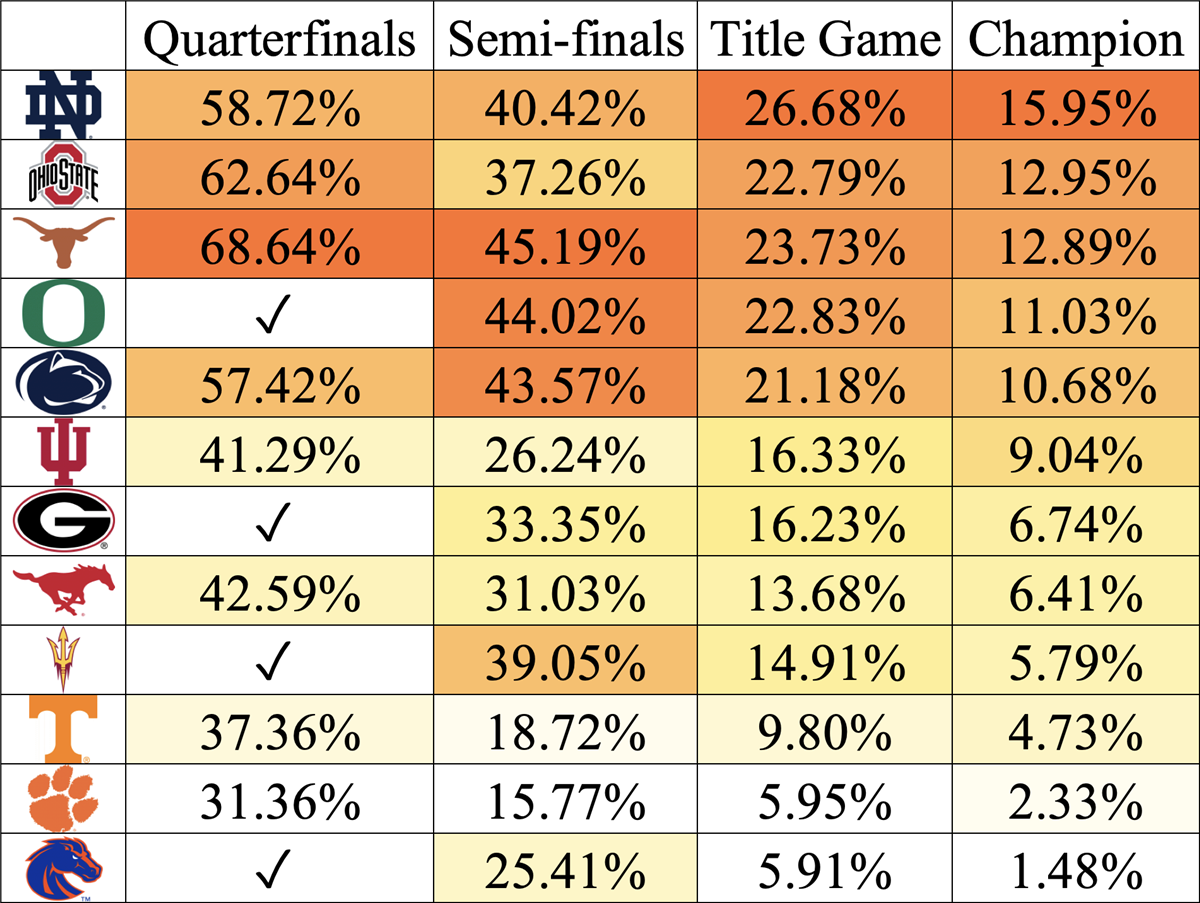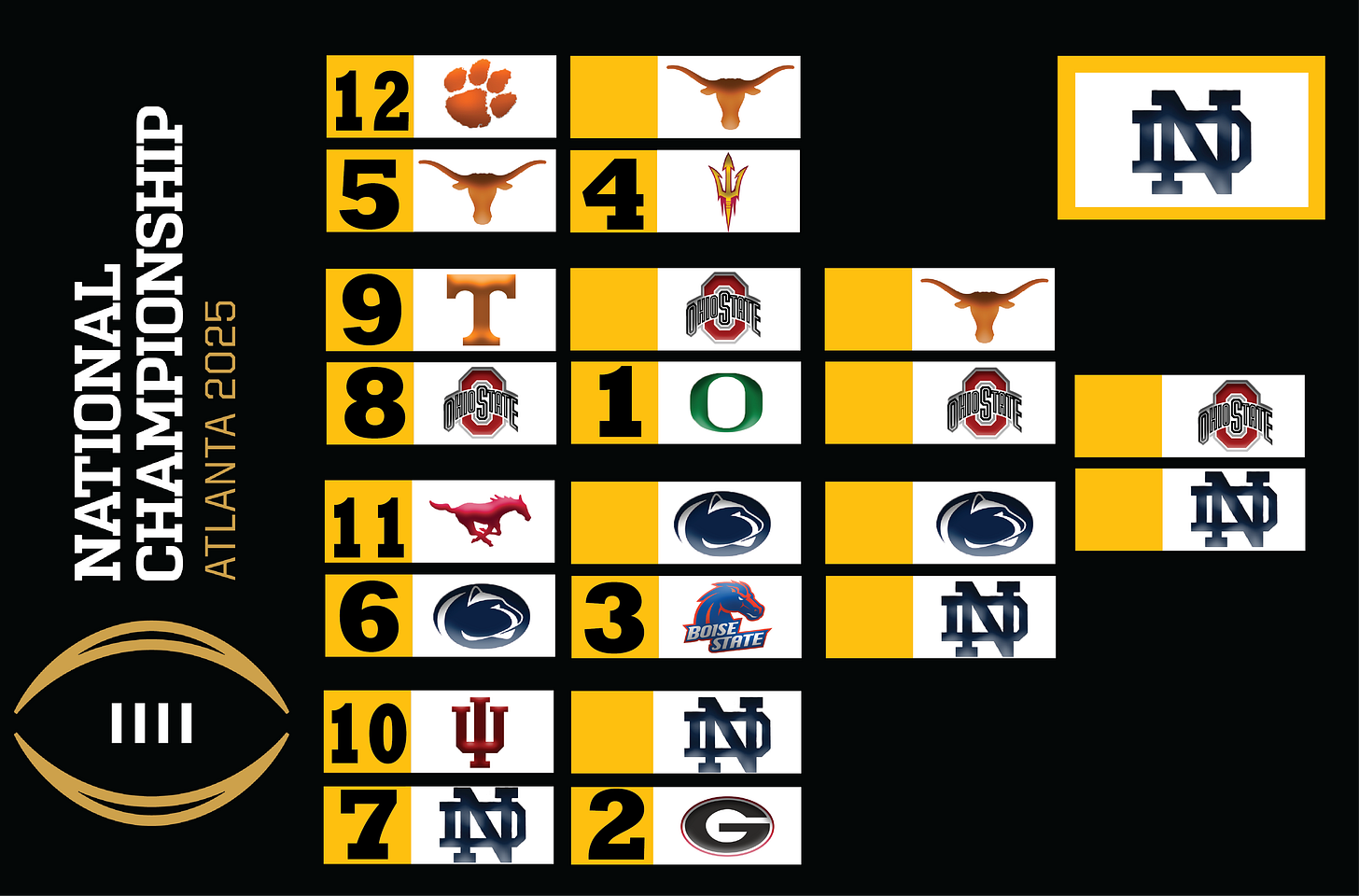CFP Prediction: Is Notre Dame Really Going to Win it All?
I used ZeLO to predict the chance that each of the 12 CFP teams could win the national championship. The results surprised me.
One of the best parts of March Madness is filling out a bracket. And with the College Football Playoff expanding to 12 teams, people have also begun filling out CFP brackets.
So, I thought I'd use ZeLO, my college football predictive model, to make a bracket.
The only thing I had to do was make a "CFP Simulator," which could quickly run through as many permutations of the CFP as possible. ZeLO is based in Excel, which isn't really suited to the task, so I wrote a standalone script to accomplish it, which can be found here.
All that was left was to run the simulator as many times as needed to yield a legitimate sample size. I ended up picking 100,000. I reasonably could have run 10,000, but the extra runtime was worth the accuracy gain.
The results are below:
There are obviously bound to be a few reasonable objections, so let's go through on a team-by-team basis.
Oregon: ZeLO was pretty high on the Ducks during the preseason, and while Oregon has looked fairly dominant, the Ducks tend to get a lead and sit on it.
That further reflects that there isn't one genuinely dominant team this year. Sure, there are a lot of good teams, but 2019 LSU, 2020 Alabama, and [insert your favorite juggernaut of the last quarter-century here] would probably beat this entire field.
Georgia: Georgia is my single least favorite prediction. ZeLO is pretty low on the Bulldogs because, from a boxscore perspective, they have been pretty unimpressive. They also face Notre Dame in the second round more often than not, and ZeLO would currently take the Irish head-to-head.
This prediction generally causes the most disagreement. I understand; it has driven me crazy for most of the season.
But I can't just make a change because I want to or because Vegas tells me I'm wrong. That's not how a systematic mathematical approach works. I can make changes, but changing one team's rating would require changing every team's rating.
I think it's wrong, though. To be this out of line with Vegas and with FPI suggests that either:
the market is wrong (it isn't), and ZeLO is exploiting some sort of inefficiency
or
ZeLO is wrong.
However, while Georgia should have a higher chance of winning the CFP outright, I stand with ZeLO. Notre Dame is better than this iteration of the Bulldogs.
Boise State: Sorry, Boise. I love Ashton Jeanty's. The Broncos can hang with any Power 4 team, but I have a hard time seeing them do it three times in a row.
Arizona State: The Sun Devils fall into a similar spot as Boise State. ASU can advance a round or two, but it's difficult to see them winning it all.
The Big 12 felt like a random number generator this year, with every team being able to win a given game every Saturday. The prize? A ticket to the CFP. The likely outcome? A second-round exit.
Texas: I predict Texas will beat Clemson. The Tigers are 0-2 against SEC teams this year with a -34-point differential.
The Longhorns drew a relatively easy path to the semi-finals. They'll likely be heavy favorites in the second round against Arizona State.
Penn State: Penn State got weirdly lucky by losing the Big Ten title game.
Let's assume that Penn State would have taken the second seed.
Instead of waiting for Notre Dame and getting extra time off, the Nittany Lions would have to face SMU at home and Boise State. I'd take that trade.
Or, assuming Penn State would have gotten the No. 1 seed (unlikely), they would have had a bye but then been rewarded with Tennessee or Ohio State.
It's good to be the sixth seed.
Beyond the general objection of "they can't win a big game" (a valid critique, mind you), Penn State seems to check out with an ≈ 11% chance of winning. I think it's less due to the team and more to the path forward.
Notre Dame: Beyond the general "Notre Dame hasn't won a meaningful bowl game in decades" objection, which I got quite a bit of on Twitter, I haven't received much pushback against ZeLO's evaluation of Notre Dame.
The Fighting Irish are good. For better or worse, that NIU loss put Notre Dame into survival mode. Rylie Mills said it best: The Irish have played ten straight playoff games, forcing the team to elevate.
If there's a critique, it's that Notre Dame is similar to Indiana; the level of competition has been low, but the results have been impressive.
ZeLO is overvaluing Notre Dame, but it's unfair to say the program's odds of winning the championship are too good. Where you slot those odds is up for debate, but top-three (FPI has Notre Dame second) is being realistic, not naive.
If I had to pick Notre Dame or the field, I would take the field. But if I had to choose just one team, I would take Notre Dame.
Ohio State: I was a little surprised Ohio State clocked in at second, given their overall path, but I think Ohio State is a great football team.
That loss to Michigan was brutal and changed the perception of Ohio State. However, if you remove that loss, the Buckeyes lost by one point to Oregon. They had the ball and could have kicked a field goal to win the game.
Although the loss to Michigan concerns me, Ohio State should beat Tennessee, and there's no reason to think they also can't do the same to Oregon.
Tennessee: When I first shared the simulation results on Twitter, I didn't get many objections about Tennessee. Based on the quality of the Tennessee squad and the path, the Vols at 5% are pretty fair.
Indiana: If Georgia is the biggest problem I have with ZeLO, Indiana is the second biggest problem.
ZeLO uses weighted averages for the first ten weeks of the regular season, factoring in the last four seasons combined with the current season. This method ensures stability by preventing ratings from fluctuating week to week.
By the time Indiana was 6-0, ZeLO had picked up a bias toward the Hoosiers. Because Indiana tends to keep its foot on the gas for all four quarters, the model is somewhat hoodwinked into thinking Indiana is a lot better than the Hoosiers really are. It's almost the opposite of the Oregon problem.
I accounted for this by factoring in the strength of the schedule, which slightly lowered Indiana's rating but not enough to completely fix the problem.
The real fix would be to implement a quality control grade for each result or add an ESPN game control factor, but that's more of an off-season project.
SMU: The roughly 6.5% chance SMU has feels slightly high, but it isn't unreasonable. If SMU beats Penn State, the Mustangs would likely be favored over Boise State.
You have to win that game, but once you make it to the semi-finals, you really do have a puncher's chance.
Clemson: The Tigers are sizeable underdogs to Texas, but if they pull off the upset, they would be favored over Arizona State. After that, they play either Tennessee, Ohio State, or Oregon.
It feels like a lot to ask this iteration of the Tigers to win three games in a row.
Is my simulation perfect? No. But I think it's an interesting approximation of what could happen.
When I initially ran the simulation, I compared it to ESPN's FPI. Here are both teams top-four, in order:
FPI: Texas, Notre Dame, Georgia, Ohio State
ZeLO: Notre Dame, Ohio State, Texas, Oregon
Which model will be correct? We'll just have to wait until Friday to find out.



